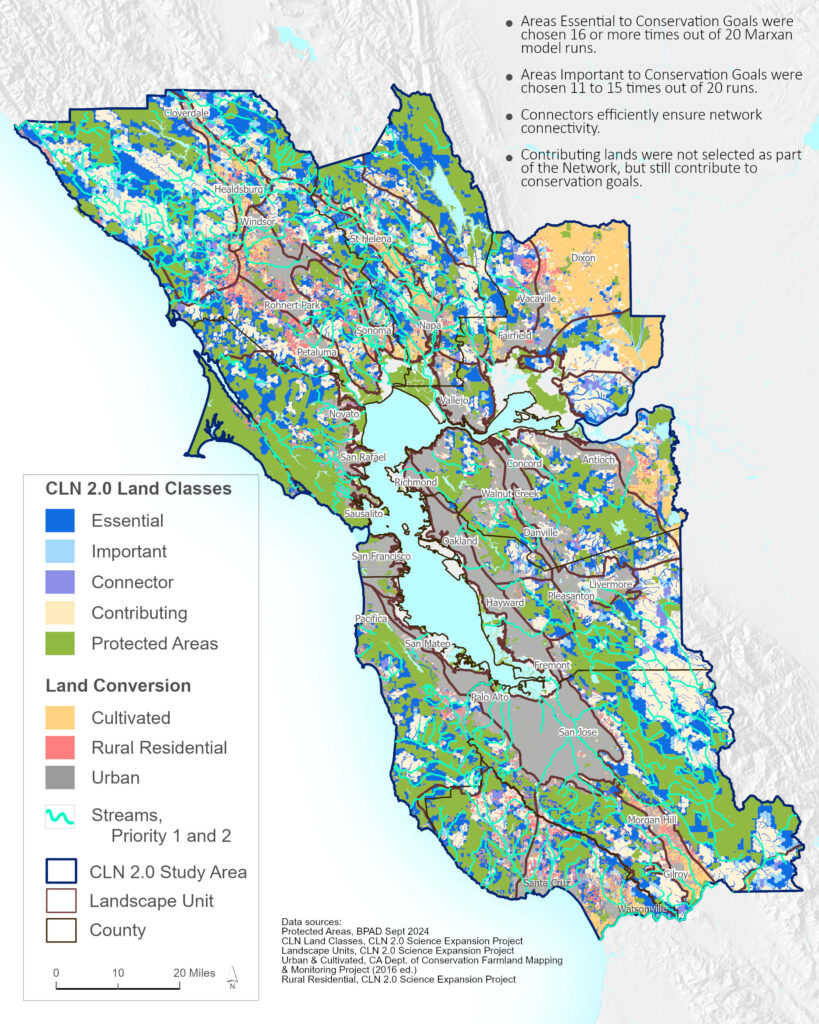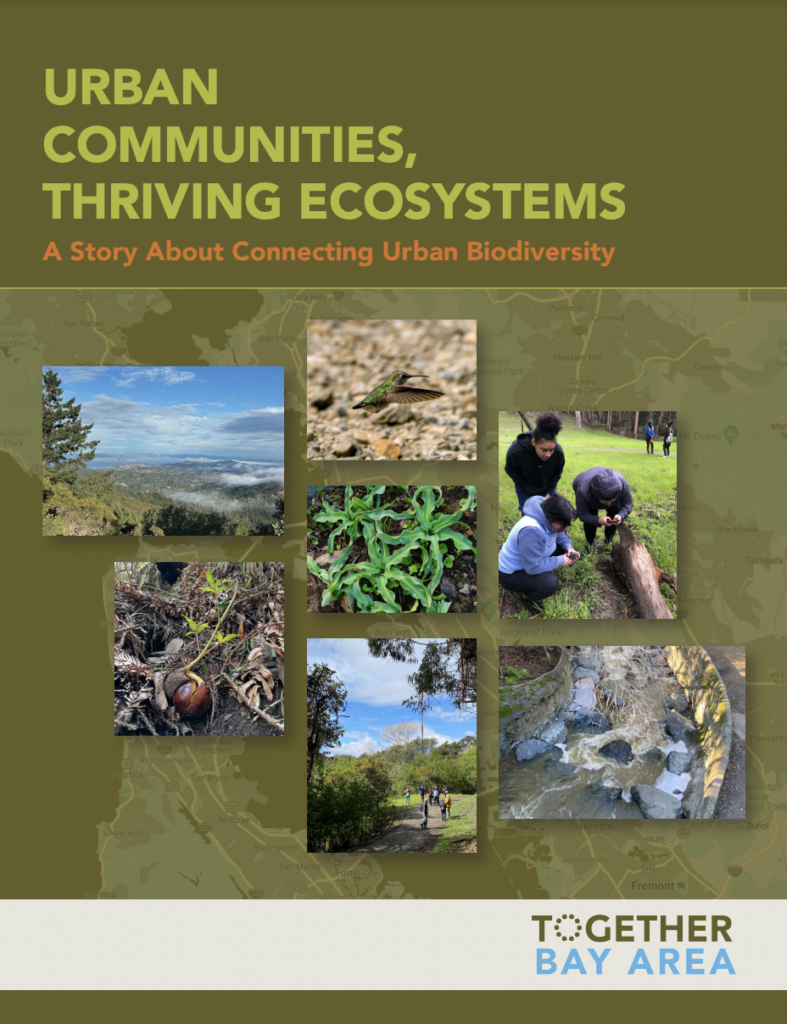Coordination of a Regional Biodiversity Conservation Strategy
Our goal is to facilitate the conservation of 50% of the Bay Area’s lands by 2050 by collaboratively setting regional goals that support local conservation and help achieve state-level strategies.
In 2019, through a peer-reviewed, science-based process, over 100 scientists, researchers, and land conservation practitioners identified regional goals for the conservation of biodiversity habitats.
Our regional conservation goals are:
Conserve 2.5 million acres of priority lands by the year 2050. 2.5 million acres is approximately 50% of Bay Area land
Conserve rare, diverse, and irreplaceable landscapes, and manage them for health and resilience.
Conserve core habitats and the lands that connect them, and manage them for permeability, health, and resilience.
Conserve a regional network of streams, wetlands, ponds, seeps, and associated riparian and upland areas, and manage for health and resilience.
Steward all lands to maintain ecological and hydrological processes that support ecosystem function and resilience.
Conservation Lands Network
The Conservation Lands Network (CLN) is a regional strategy that has been setting goals, tracking progress, providing tools, and catalyzing on-the-ground land conservation in the San Francisco Bay Area since 2006.
The CLN articulates two types of science-based and community-driven goals: a set of five overarching regional conservation goals and a much larger set of habitat-specific goals.
The CLN tools focus conservation in areas that represent the region’s biodiversity and support ecological function across the nearly 5 million acres that comprise the 10 Bay Area counties.
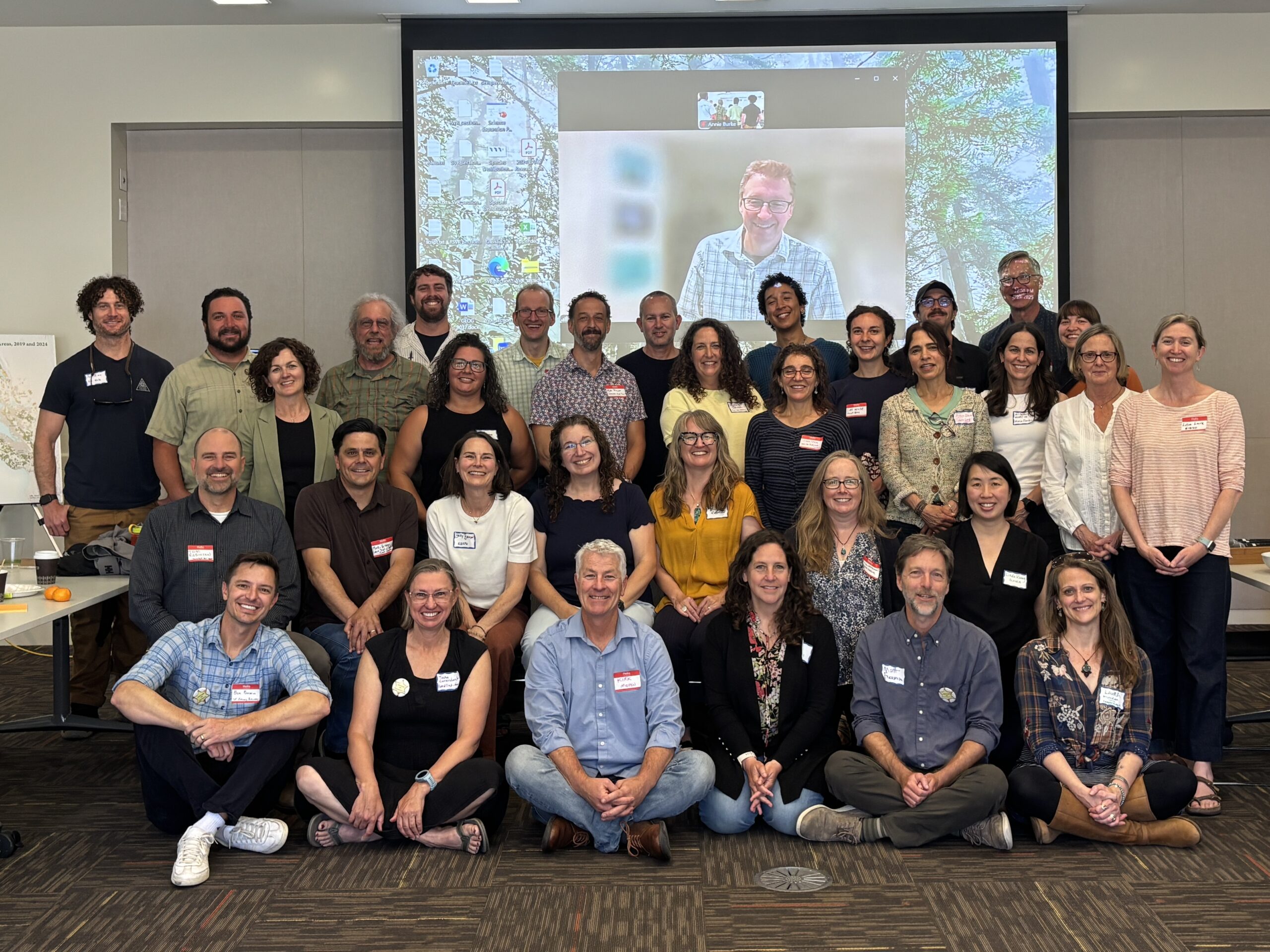
The Conservation Lands Network 3.0 Steering Committee, May 29, 2025
CLN 3.0
In 2025, with support from the State Coastal Conservancy, TOGETHER Bay Area has launched a multi-year effort to update and expand the Conservation Lands Network with version 3.0. Our goals include:
- Through an inclusive process with the CLN community, produce CLN tools and deliverables including maps, data, online Explorer tool, and a written report.
- Engage experts to determine if/how there are meaningful and useful ways to incorporate wildfire, urban areas, stewardship, and agricultural lands into the CLN’s tools and deliverables that help advance 50×50.
- Identify ways to integrate the CLN with other TOGETHER programs including advocacy for regional funding and building alliances with Native American Tribes and communities.
CLN 3.0 Steering Committee
The Steering Committee provides oversight on all aspects of the project, including ensuring the scientific integrity of the project, providing guidance on what new data should be included and interpreted, involving key stakeholders, and developing final recommendations.
- Allison Schichtel, Sonoma County Ag & Open Space
- Anna Weinstein, Solano Land Trust
- Becky Bremser, East Bay Regional Park District
- Ben Botkin, San Francisco Estuary Partnership/MTC
- Ben Teton, Santa Clara Valley HCP
- Carrie Schloss, The Nature Conservancy
- Dan Rademacher, GreenInfo Network
- Dina Robertson, East Bay Regional Park District
- Emily Corwin, San Francisco Estuary Institute
- James Wilson, John Muir Land Trust
- Jessica Davenport, State Coastal Conservancy
- Joe Issel, San Mateo RCD
- Kellyx Nelson, San Mateo RCD
- Kirk Lennington, Midpeninsula Regional Open Space District
- Kyle Pinjuv, Sonoma Land Trust
- Laura McLendon, Sempervirens Fund
- Lena Pollastro, Land Trust of Napa County
- Linda Kwong, Santa Clara Valley Open Space Authority
- Lisa Lomba, John Muir Land Trust
- Lisa Lurie, Santa Cruz County RCD
- Mark Bibbo, Land Trust of Santa Cruz County
- Mark Kalnins, State Coastal Conservancy
- Matt Freeman, Matt Freeman Consulting
- Matt Gerhart, Northern Virginia Conservation Trust
- Mischon Martin, Marin County Parks
- Nancy Schaefer, California Rangeland Trust
- Neoma Lavelle, East Bay Regional Park District
- Peter Cowan, Peninsula Open Space Trust
- Rebecca Johnson, California Academy of Sciences
- Robin Grossinger, Second Nature Ecology and Design
- Sara Press, Save the Redwoods League
- Stu Weiss, Creekside Center
- Tom Gardali, Audubon Canyon Ranch
- Tosha Comendant, Land Trust of Napa County
- Tristen Brenner, Marin Agricultural Land Trust
Science Advisors
- Cesar Estien, PhD, Second Nature Ecology + Design
- Erica Spotswood, PhD, Second Nature Ecology + Design
- Stu Weiss, PhD, Creekside Center for Earth Observation
- Liat Wilde, MA, Point Blue Conservation Science
CLN 2.0 Progress Report
Released in December 2024, the CLN 2.0 Progress Report measures progress on the five regional goals since the CLN community set them in 2019. This report reflects the work of local conservation organizations who have worked tirelessly to conserve new lands. It contains scientific analysis and interconnections to state goals and regional planning processes. Key findings include:
We are making progress. More than 130,000 acres have been conserved over the past five years, bringing us closer to our regional goal of conserving 50% of the Bay Area’s lands by 2050. And those acres include important and essential habitats for native animals like Coho salmon, Alameda whipsnake, and Golden Eagles. This progress means enhanced resilience to the impacts of climate change and reduced risk of losing species to extinction.
We are collaborating. Around 150 people contributed their expertise and time to create CLN 2.0 and the goals against which we’re measuring progress. Dozens of organizations, dozens of funding agencies and foundations, hundreds of researchers, and thousands of practitioners are collaborating on a daily basis to conserve and steward the region’s lands. And through collaboration we will achieve much more, with more durability, than what we could do alone.
And we aren’t stopping anytime soon. Starting in 2025, we will convene over 300 practitioners and experts to assess the health of the region’s habitats, set new goals for land conservation, and evolve the CLN project to meet today’s challenges and opportunities. The outcome will be clear goals and metrics, and a large and diverse community of professionals and practitioners mobilized to reach those goals. We invite you to join us. There’s a lot to be hopeful about.
Connecting Urban Biodiversity project
On November 7, 2019, over 100 people gathered at the Gordon and Betty Moore Foundation in Palo Alto for an event to announce the second version of the Conservation Lands Network (CLN). The CLN is a regional strategy that sets goals, tracks progress, provides tools, and catalyzes on-the-ground land conservation in the San Francisco Bay Area. The CLN 2.0 included a map of the Bay Area that highlighted in bright colors the lands that are essential and important for conservation and those that are already conserved. The map created a vibrant, visual representation of conservation opportunity and value.
But not all Bay Area lands were included: Urban areas had been grayed out. In the dominant paradigm in conservation planning at the time, urban areas were considered to have little to no conservation value. In terms of conservation planning, urban spaces were literally left off the map.
At the reception that day, Dr. Rebecca Johnson asked: Could community science illuminate the value of urban areas for biodiversity conservation?
The Connecting Urban Biodiversity project was born from this question.
Wildfire Data Working Group
As hundreds of thousands of acres of the Bay Area have burned recently in wildfires, our members are in a constant cycle of research and innovation as we learn to live with fire on the landscape. Collecting and analyzing data to support this paradigm shift is key. The Wildfire Data Working Group (WDWG) is focused on regional coordination of data collected before, during, and after wildfires for informed decision making by land management organizations and agencies. TOGETHER Bay Area convenes this working group of data compilers to learn from one another, share information, and build our regional understanding of the impacts of fire on the land.
Watch recordings of past sessions >
Want to get involved? Email [email protected] to sign up.
Partnership with FLAME
FLAME (the Fire-resilient Lands Alliance [for the Management of Everything]) is a regional working group that aims to connect professionals in the greater nine-county San Francisco Bay Area (and adjacent) who delve in fire and natural resource management. With an interdisciplinary approach from individuals working in local fire departments to federal, state, county organizations and the likes, this group will meet to discuss and work through challenging topics regarding fuels reduction and wildfire hazard mitigations, as well as share lessons learned and project successes with on-site field trips.
Since most wildfire-related topics have a planning and data side and an implementation side, the Wildfire Data Working Group and FLAME work in partnership to better serve a broad range of wildfire-related positions by efficiently moving forward a common agenda.
Want to get involved? Contact Tatiana Manzanillo, [email protected]
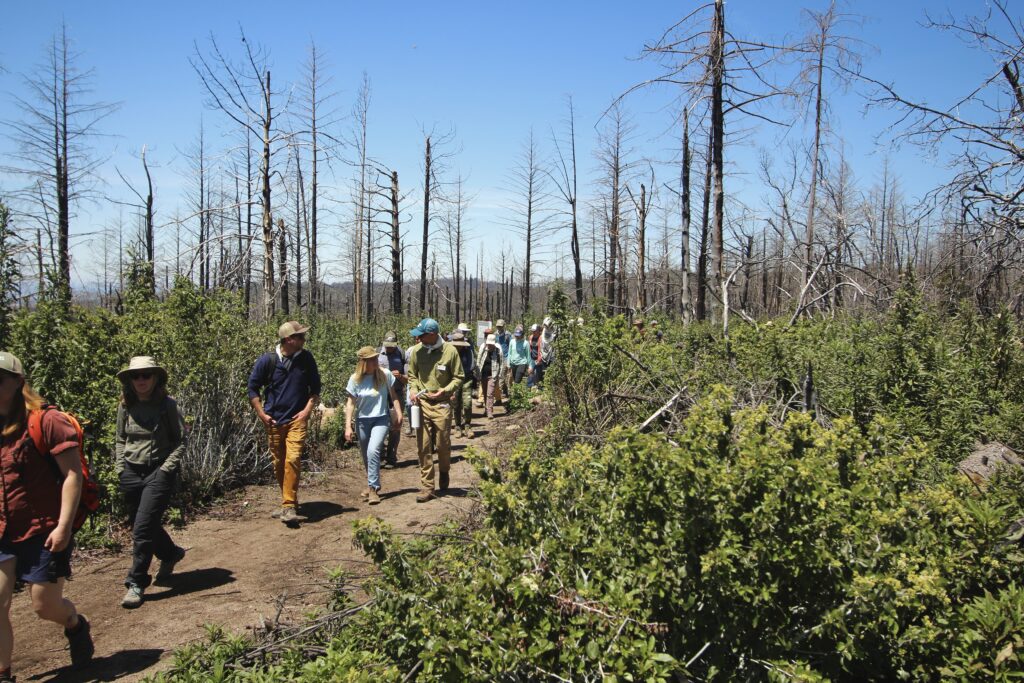
The Bay Area Greenprint
The Bay Area Greenprint is a tool that reveals the multiple benefits of natural and agricultural lands, empowering users to inform land use and infrastructure decisions with better data. The Bay Area Greenprint identifies, maps, and measures the values that nature contributes to the Bay Area ecosystem, the economy, and local and regional communities.
The Bay Area Greenprint is a collaboration of The Nature Conservancy, TOGETHER Bay Area, American Farmland Trust, Greenbelt Alliance, and GreenInfo Network. Funding provided by the S.D. Bechtel, Jr. Foundation, the Metropolitan Transportation Commission, and the Stanford University’s Natural Capital Project.
News
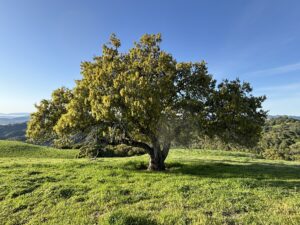
Ready? Set? Go! Prop 4 funding is on its way
The Legislature and Administration have passed SB 105, pushing $3.2 billion of Proposition 4 funding out the door. It’s go time, and here’s what that means for TOGETHER Bay Area.
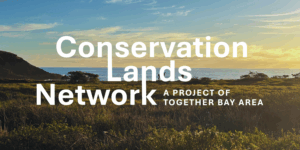
The who and how of CLN: a summary of users and use cases
From land trusts and government agencies to students and consultants, the Conservation Lands Network is supporting conservation action across the Bay Area.
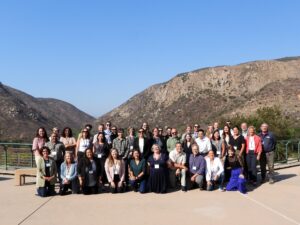
Circus performers, porcupines, and 30×30 in San Diego
Last week I traveled to San Diego to participate in California’s 30×30 Partnership Summit. And what I saw blew my mind.

